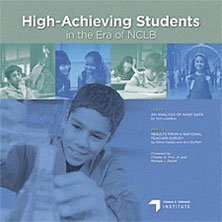

High-Achievers &
“No Child Left Behind”
“No Child Left Behind”

High-Achievers & “No
Child Left Behind”
 No Child
Left Behind (NCLB), the landmark education reform law that took effect
in 2002, has been associated with a dramatic improvement in the achievement
of the lowest-performing American students. But its apparent effect on
the nation’s top students has been very different; their scores have stagnated.
These are among the key findings of “High-Achieving Students in the Era
of NCLB,” a multi-year, five-part investigation conducted by the Thomas
B. Fordham Institute and supported by a grant from the John Templeton Foundation.
No Child
Left Behind (NCLB), the landmark education reform law that took effect
in 2002, has been associated with a dramatic improvement in the achievement
of the lowest-performing American students. But its apparent effect on
the nation’s top students has been very different; their scores have stagnated.
These are among the key findings of “High-Achieving Students in the Era
of NCLB,” a multi-year, five-part investigation conducted by the Thomas
B. Fordham Institute and supported by a grant from the John Templeton Foundation.
 The first two phases of the study were released in June. Part I, “An Analysis
of NAEP Data,” by Brookings Institution scholar Tom Loveless, examines
achievement trends for students who performed at a high level on the National
Assessment of Educational Progress. Part II, “Results from a National Teacher
Survey,” by Steve Farkas and Ann Duffett, reports on how teachers see high-achieving
students being treated in the NCLB era. The researchers found that most
teachers want all of their students to have challenging material and a
fair share of attention.
The first two phases of the study were released in June. Part I, “An Analysis
of NAEP Data,” by Brookings Institution scholar Tom Loveless, examines
achievement trends for students who performed at a high level on the National
Assessment of Educational Progress. Part II, “Results from a National Teacher
Survey,” by Steve Farkas and Ann Duffett, reports on how teachers see high-achieving
students being treated in the NCLB era. The researchers found that most
teachers want all of their students to have challenging material and a
fair share of attention.